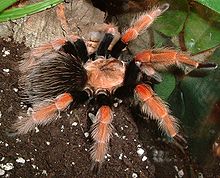- Brachypelma boehmei
-
Brachypelma boehmei 
Scientific classification Kingdom: Animalia Phylum: Arthropoda Class: Arachnida Order: Araneae Family: Theraphosidae Genus: Brachypelma Species: B. boehmei Binomial name Brachypelma boehmei
Schmidt & Klaas, 1993Brachypelma boehmei, (also known as the Mexican fireleg,[1] or the Mexican rustleg tarantula), is a tarantula native to Mexico in Estado Guerrero - state.[2]
These tarantulas prefer semi-humid climates, and are obligate terrestrial burrowers. As with all closely related tarantula species, they defend themselves with urticating hair when provoked. They are not the easiest species to keep in captivity and should be only considered as pets once comfortable with keeping several other species.
Contents
Appearance and characteristics
The Mexican Fireleg resembles its better known relative, Mexican redknee tarantula (Brachypelma smithi) in its dramatic orange and black coloration.[3] Though the adults of the species range from 5 to 6 inches in size. This species of tarantula has a slower growth rate than many of the larger South American tarantula species. The black femora (or upper legs) provide a dark dividing band between the rich orange color of the carapace and lower legs. Unlike the orange joints of Brachypelma smithi, the beautifully colored legs of this species are a bright, ‘fiery’ red on the patellae (or knees), fading gradually to a paler orange further down and tipped by black tarsi (or feet).[4] Although not particularly defensive, this species of spider can have a nervous temperament, where the spider can flick urticating hairs when it feels threatened.[5][6]
Range and habitat
The Mexican Fireleg tarantula is native to Mexico, where it is found along the central Pacific coast from Michoacan State to western Guerrero State,[7] where it prefers dry scrubland, and is found in burrows, either self-made or abandoned rodent or lizard burrows, usually under rocks or fallen logs.[6]
Biology
Tarantulas of this genus are long-lived, with males reaching maturity at seven to eight years, females at nine to ten. While males only live up to a year after their final molt, females may live for a further ten years. Sub-adults and adults molt at the end of the dry season (November to June), after which males begin their search for mating females. The egg-sac is laid after the female molts, and hatches three to four weeks before the rainy season begins.[4] Mexican Fireleg tarantulas tend to be active after dark, but can also be active during daylight, particularly in the morning and evening.[6]
Conservation
As with other Brachypelma species from the west coast of Mexico, this species makes a popular pet due to its docility and vivid colours, sadly leading to its over collection from the wild. The illegal pet trade, together with the ongoing destruction of natural habitat and its high mortality rate before sexual maturity, causes considerable concern for the future of this tarantula.[6]
To regulate its commercial trade across borders, this species has been listed on Appendix II of the Convention on International Trade in Endangered Species (CITES). In Mexico, permits are required to collect or remove any spider of the family of tarantulas, Theraphosidae[7] and the Mexican Fireleg tarantula is now frequently bred in captivity, reducing the need to collect it from the wild.[4]
As Pets
In captivity, adult Brachypelma Boehmei usually feed on crickets, super meal worms, meal worms, dubia roaches, house gecko and even pinkies (which is not recommended), spiderlings will usually feed on pre-killed mealworms, pinhead crickets, baby dubia roaches, wingless fruit flies, and any other small insects which are not defensive.
If keeping tarantulas as a hobby, it is always better to be reminded that Brachypelma boehmei and many other tarantulas are endangered species. It is advised to keep only captive-bred (farm-bred or home-bred) tarantulas rather than wild-caught ones.
References
This article incorporates text from the ARKive fact-file "Mexican rustleg tarantula" under the Creative Commons Attribution-ShareAlike 3.0 Unported License and the GFDL.
- ^ The Omaha Newspapers
- ^ Map
- ^ "Brachypelma boehmei". Latrodectus.net. November, 2005. http://home.arcor.de/schwaara-mail/boehmei.htm. Retrieved July 21, 2011.
- ^ a b c Locht, A., Yáñez, M. and Vázquez, I. (1999). "Distribution and natural history of Mexican species of Brachypelma and Brachypelmides (Theraphosidae, Theraphosinae) with morphological evidence to support their synonymy". The Journal of Arachnology 27 (1): 196–200.
- ^ "Tarantula". Tarantulas.com. November, 2005. http://www.tarantulas.com/fireleg.asp. Retrieved July 21, 2011.
- ^ a b c d West, R. (2008) Pers. comm.
- ^ a b West, R. (2005). "The Brachypelma of Mexico". Journal of the British Tarantula Society 20 (4): 108–119.
External links
- Brachypelma boehmei media at ARKive
- Brachypelma boehmei at the Encyclopedia of Life
Categories:- Theraphosidae
- Fauna of Mexico
- Spiders of North America
- Natural history of Guerrero
Wikimedia Foundation. 2010.

